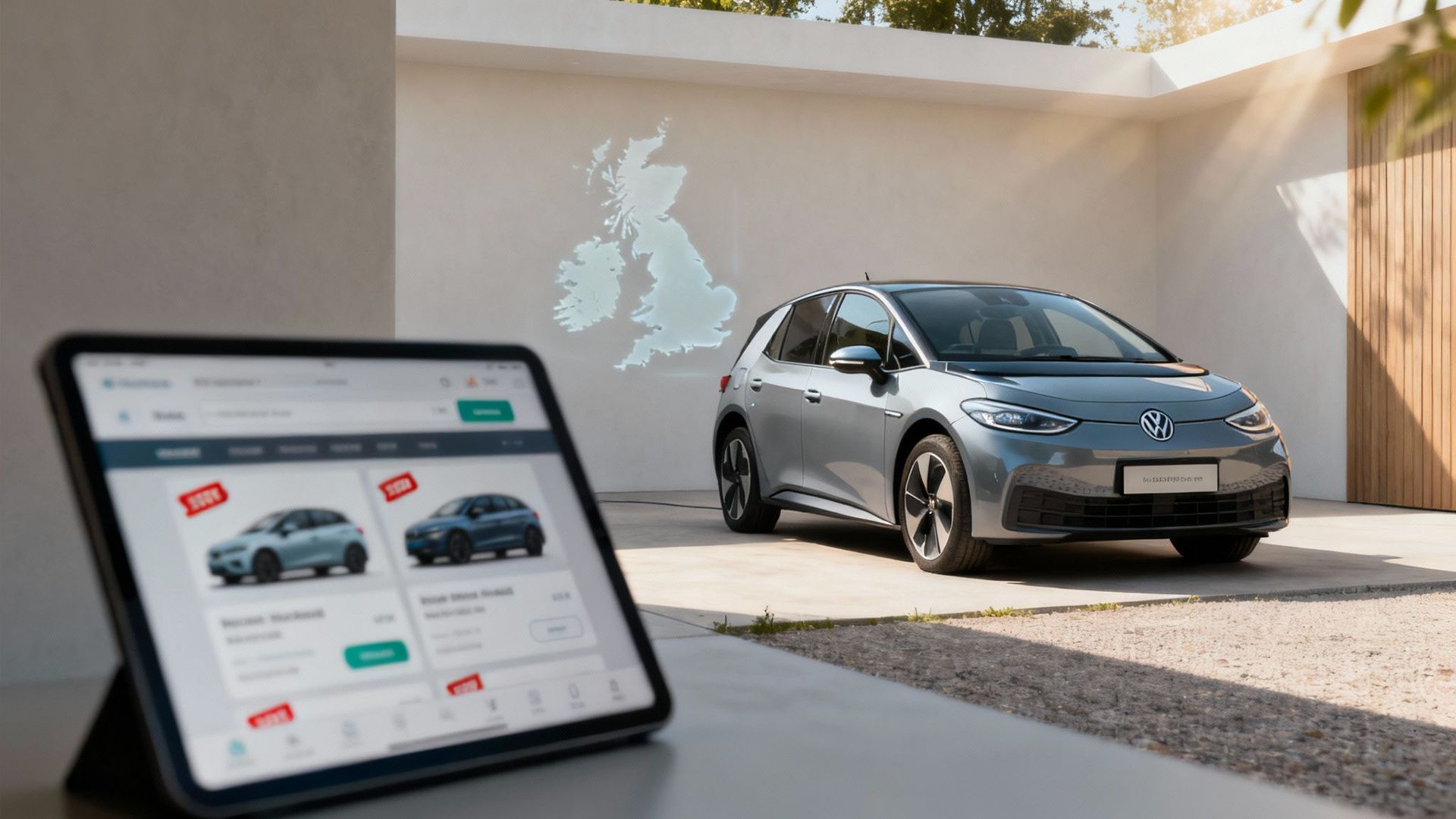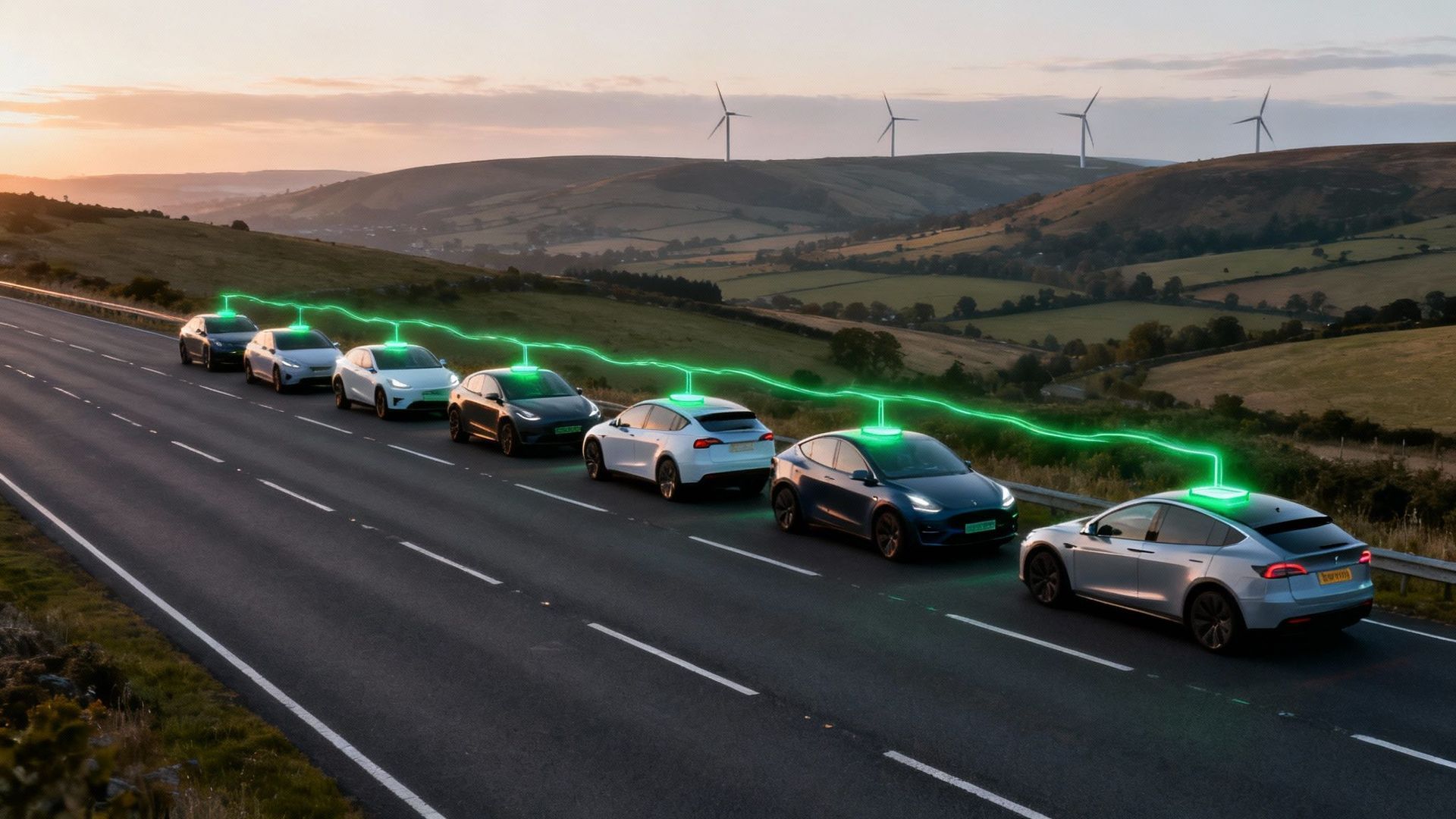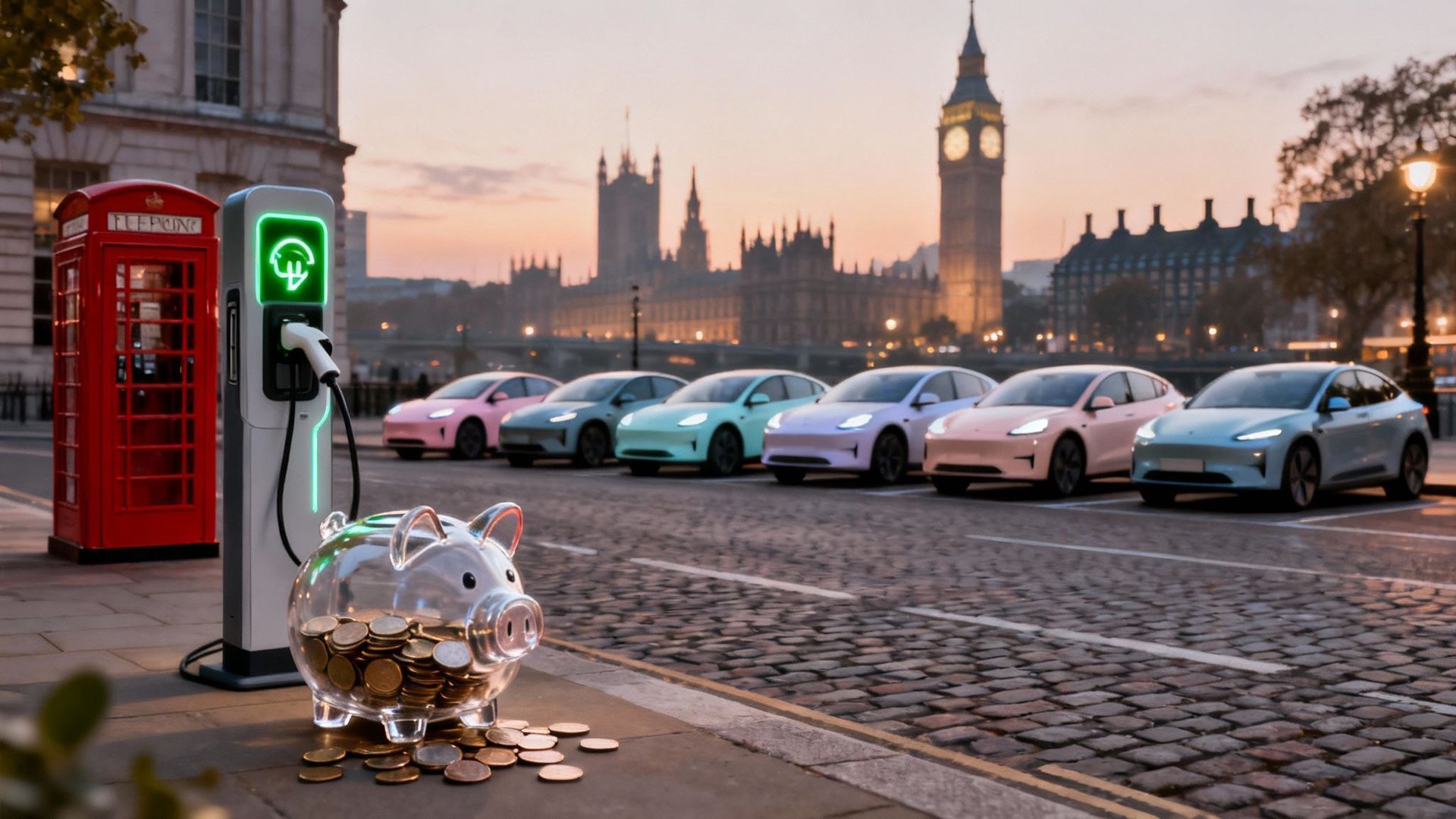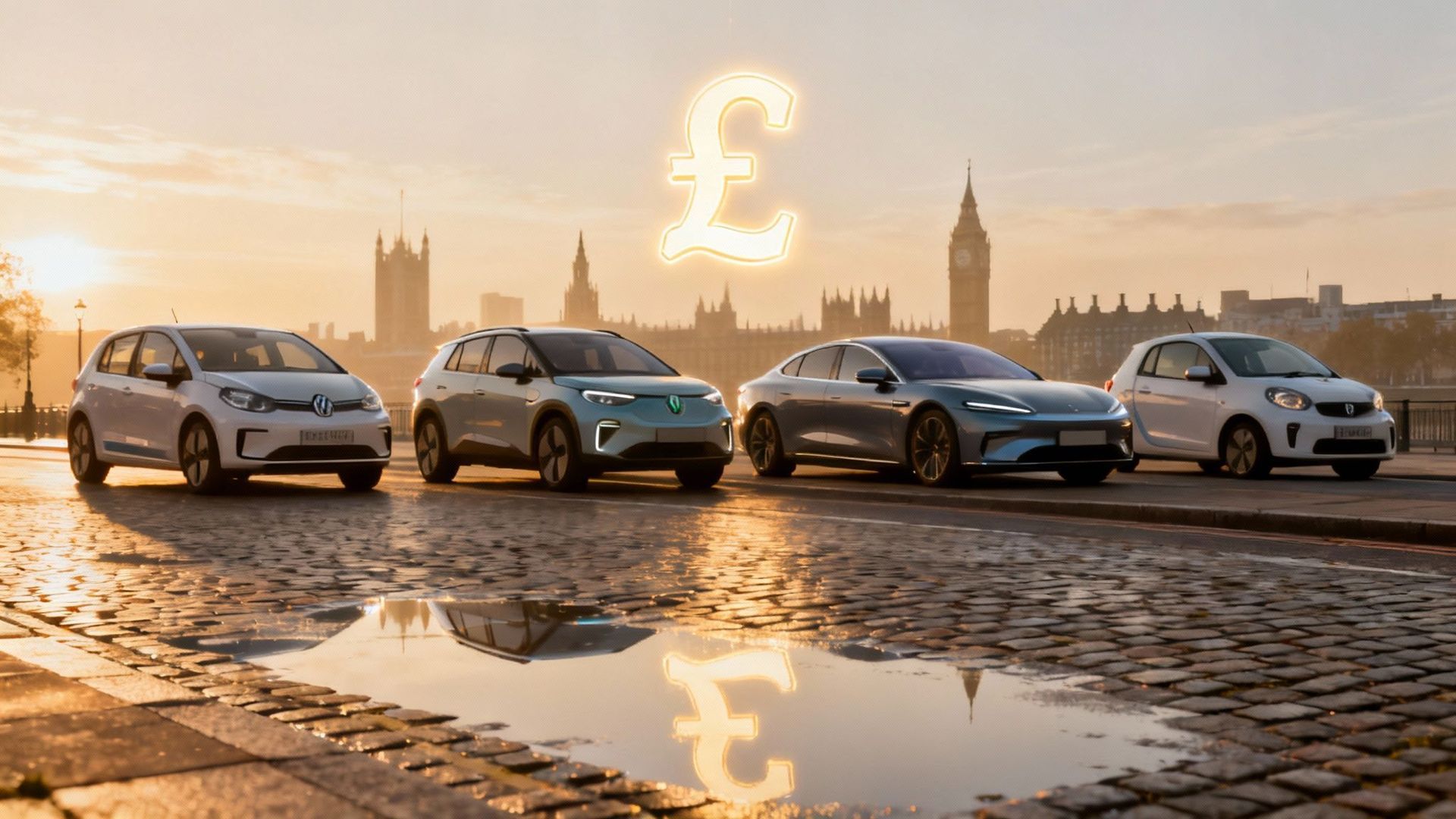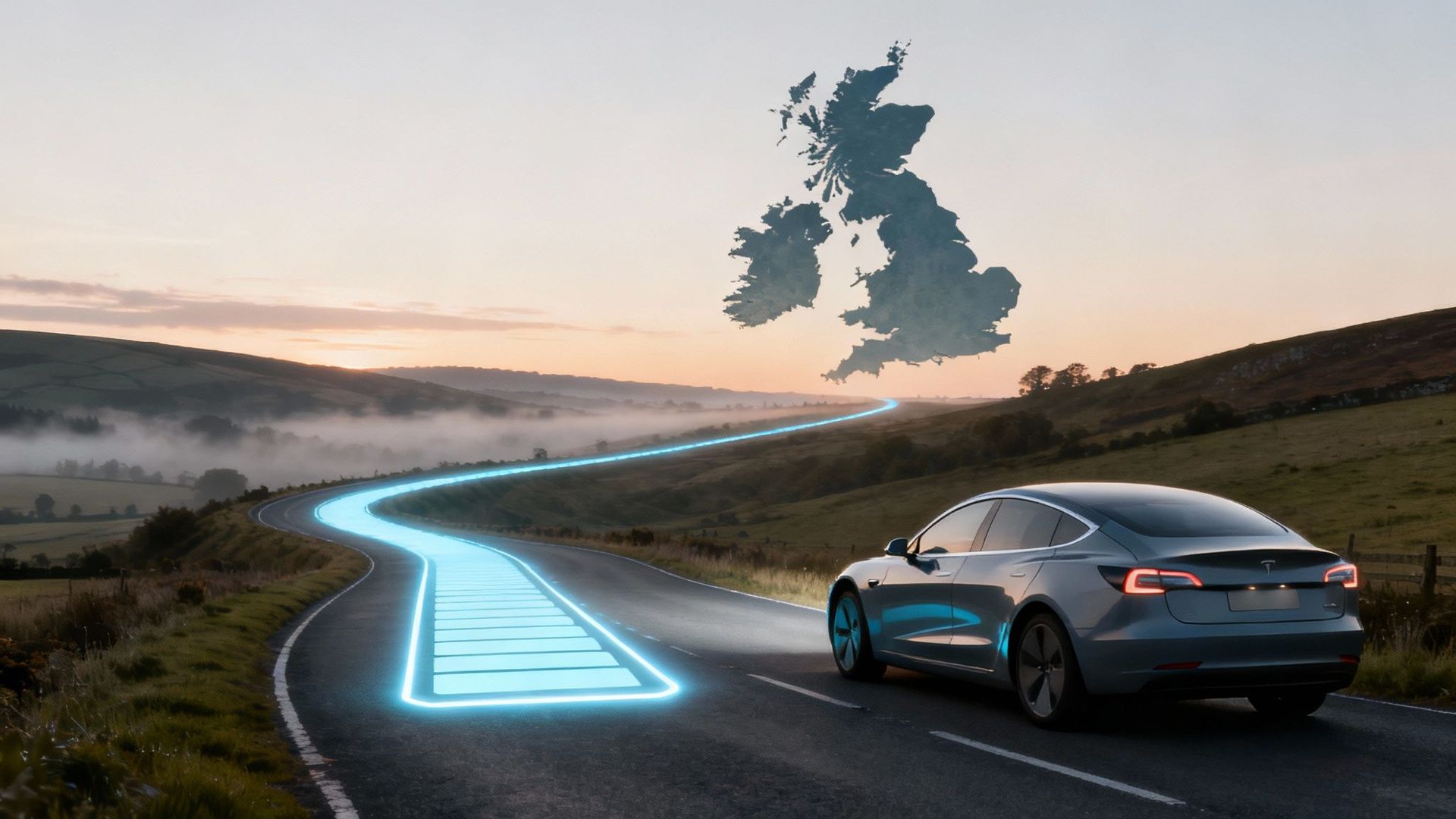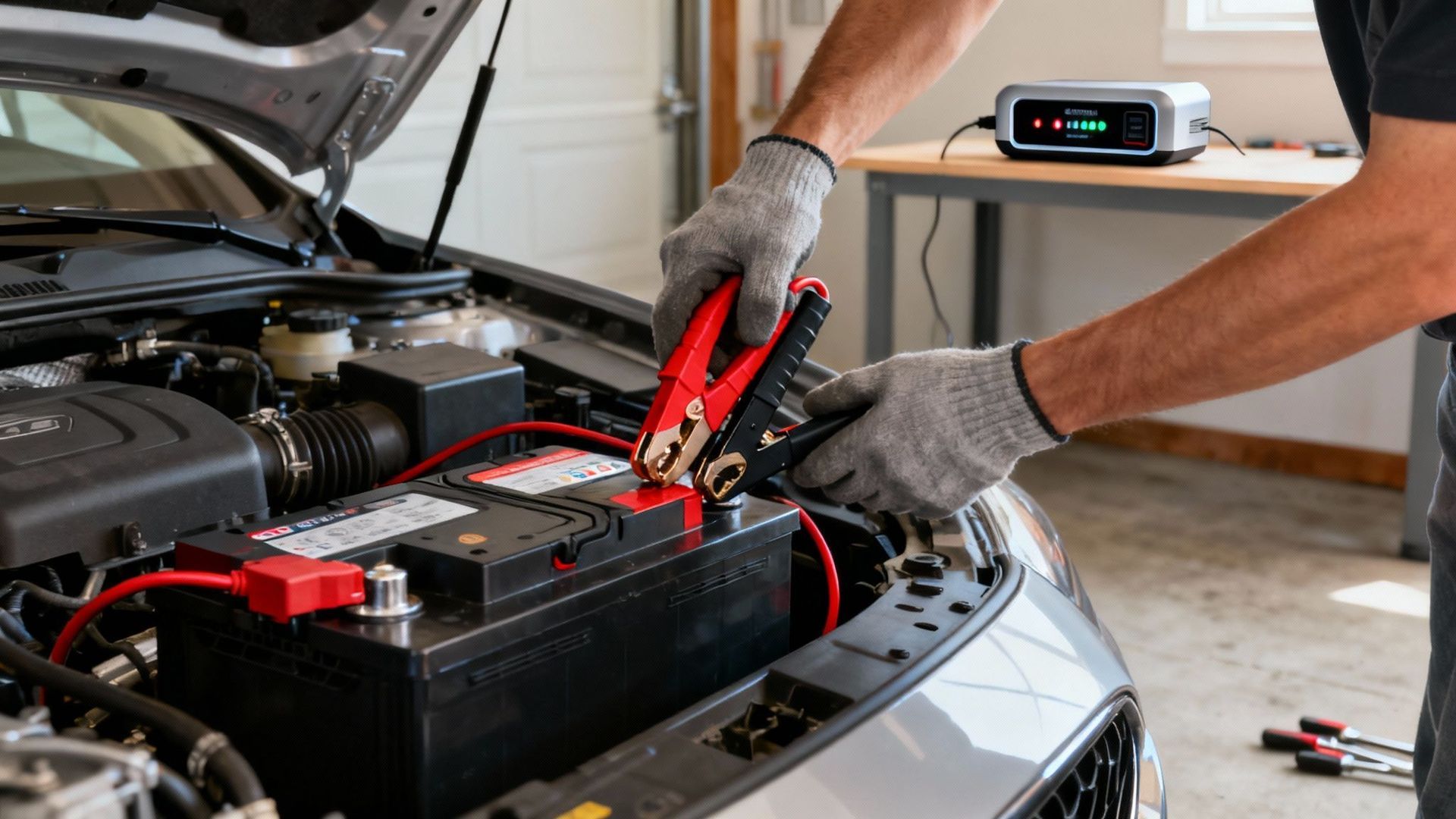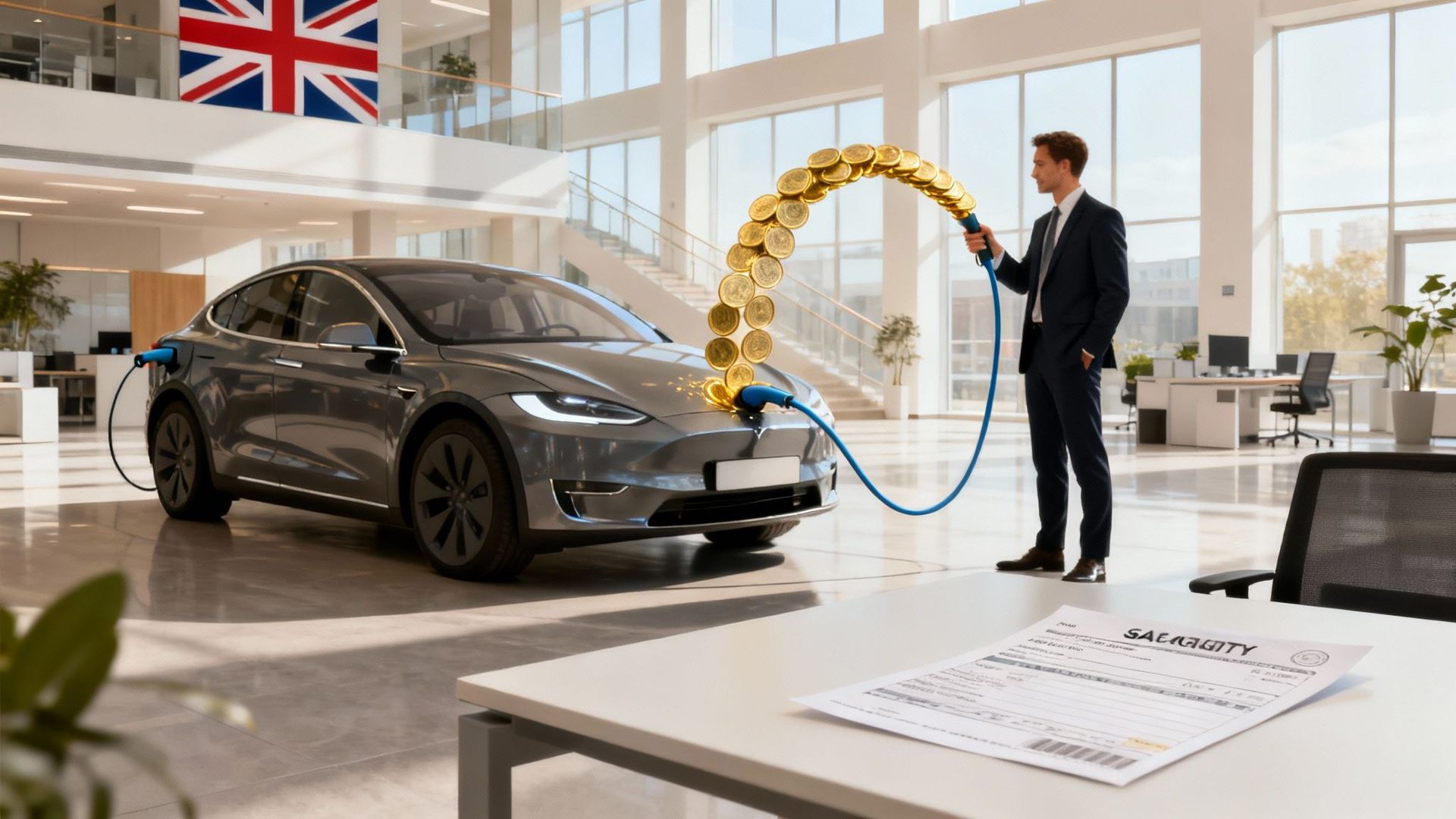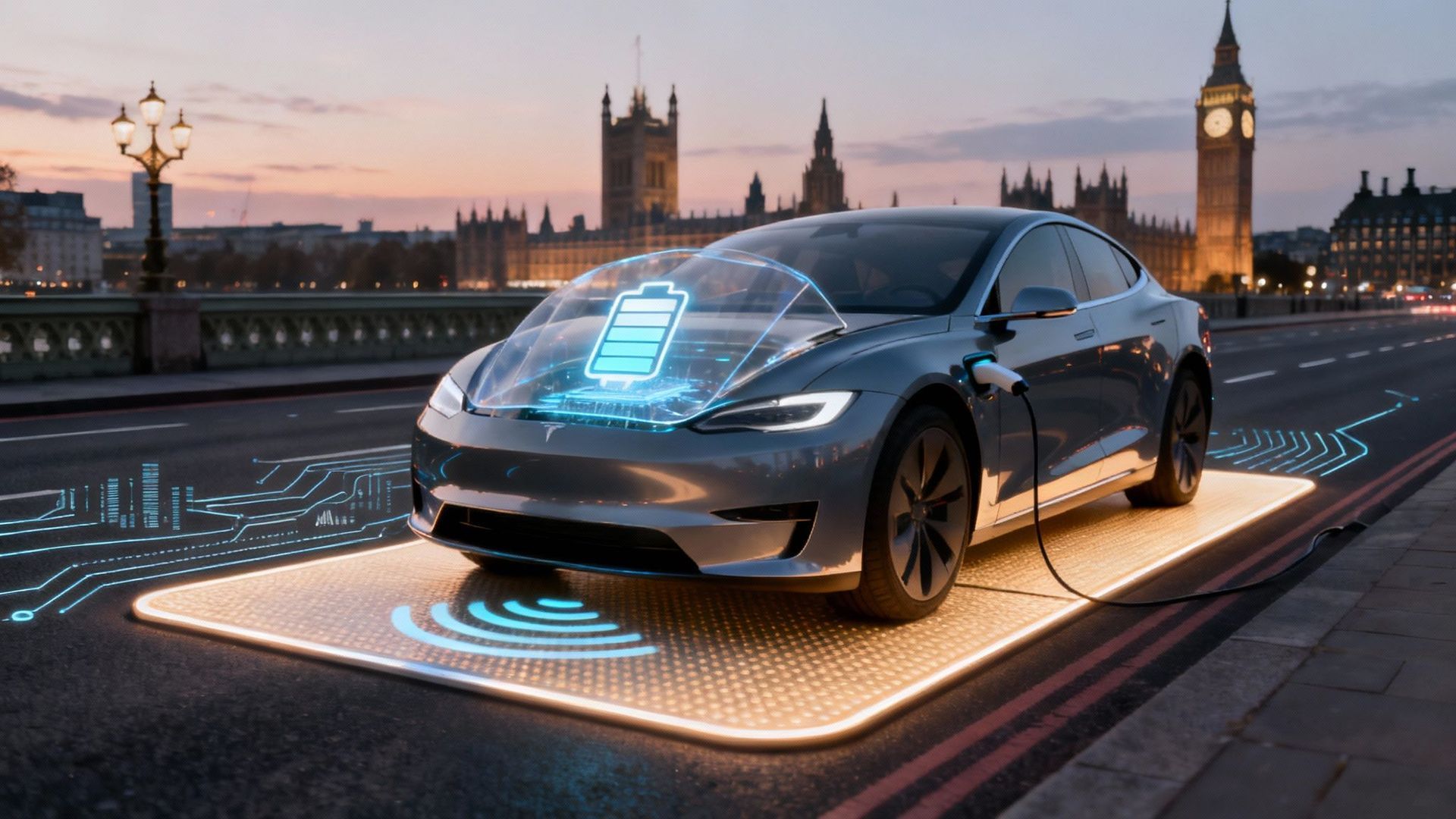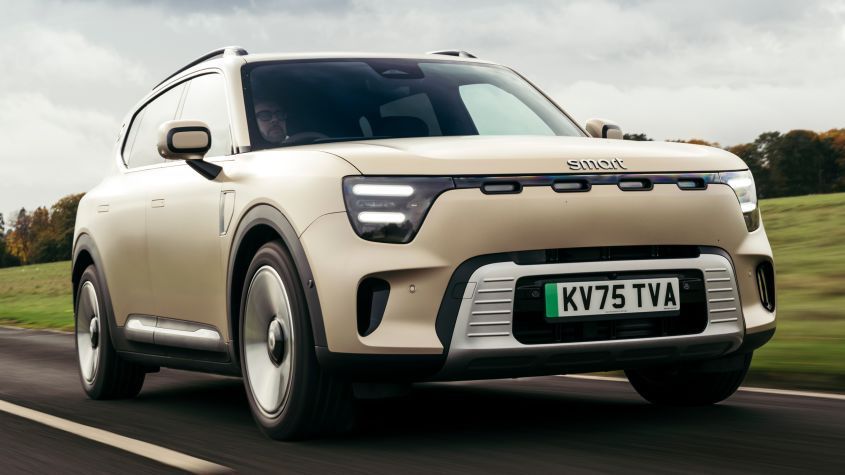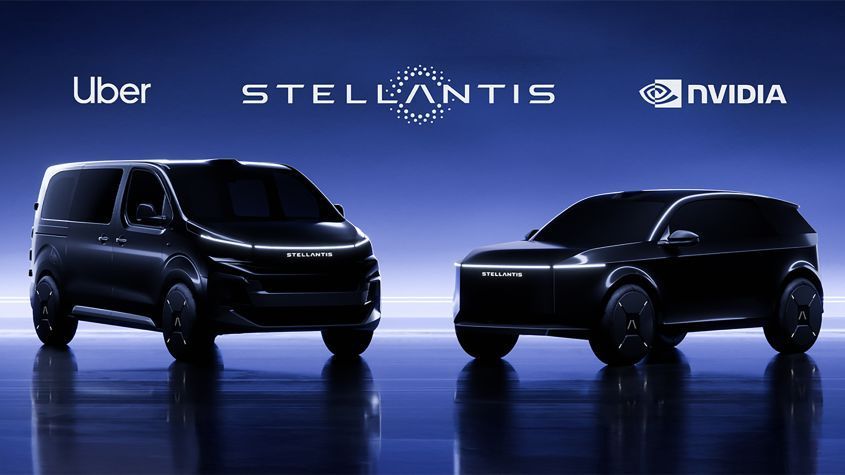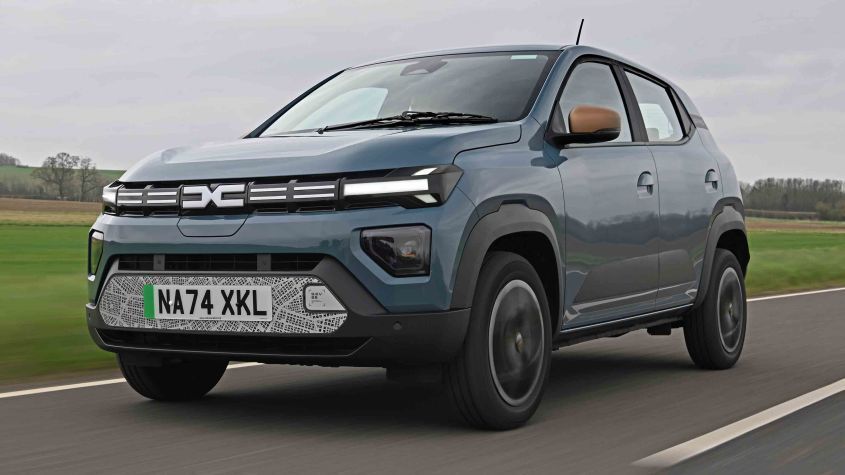EV Charging Points in the UK: A Sceptic's Guide to Not Getting Stranded
So, you’ve taken the plunge. That shiny new electric car is sitting on your drive, you’re feeling smugly virtuous, and you've just signed up for the great British sport of ‘Hunt the Working Charger’. It’s a bit like a treasure hunt, only with more apps, a creeping sense of dread about your battery percentage, and the prize is not getting stranded in Milton Keynes.
Navigating the Great British Charging Lottery
Finding a public charger when you need one can feel like playing roulette with a blindfold on. One minute, you're gliding silently down the M1, feeling like a futuristic eco-warrior. The next, your range is dropping faster than a politician's promise, and you're desperately praying the next service station has a charger that works, isn't occupied by a Nissan Leaf that’s been there since Tuesday, and has the right bloody plug for your car. This is modern motoring's answer to existential dread.
Think of this guide as your dog-eared map through the charging maze. We're going to swerve the marketing guff and cut straight to what you actually need to know about the plugs, the providers, and the sheer bloody-mindedness of a charger that refuses to talk to your car. This isn't the glossy brochure version; this is the real-world, slightly cynical guide to keeping your EV juiced up on UK roads.
What You're Really Dealing With
The UK's charging network is growing at a frankly astonishing rate, but it’s a chaotic patchwork of different companies, baffling speeds, and more plug types than you can shake a stick at. While the government loves to trumpet that we have 86,021 public charging devices as of October 2025, that number is a bit of a smoke-and-mirrors act. Dig into the full government statistics on EV charging infrastructure, and you'll see only a fraction are the super-fast rapid chargers you actually need for a quick top-up on a long haul. The rest are slower than a wet weekend in Bognor.
What this all means is that a bit of forward planning is no longer a polite suggestion—it's absolutely non-negotiable. This guide is your roadmap to avoiding that sinking feeling of being stranded at a remote service station where the only entertainment is a broken fruit machine. We'll give you:
- The Core Knowledge: A straightforward, jargon-free explanation of slow, fast, and rapid chargers.
- The Best Tools: How to use apps to find a charger without driving yourself completely round the bend.
- A Reality Check: Practical advice for when things (inevitably) go spectacularly pear-shaped.
By the time you're done here, you'll be charging like a seasoned pro. You'll be able to plan any trip with the quiet confidence of someone who knows exactly where their next electrical fix is coming from. Right, let's get plugged in.
Slow, Fast, and Rapid: Making Sense of EV Charger Speeds
Let's get one thing straight from the start: not all EV chargers are created equal. Pulling up to a charging point in the UK can feel a bit like ordering a coffee – you can get a slow drip, a standard flat white, or a triple espresso that'll have you bouncing off the walls. The difference is all about the power, measured in kilowatts (kW), and understanding this is the key to avoiding a three-hour layover at Toddington Services when you only needed 30 minutes.
Think of your car's battery as an empty bucket and the charger as a tap. The kW rating is simply how ferociously that tap flows. A higher kW number means a faster flow and a quicker top-up. It really is that simple.
But to make life interesting, the industry has given these speeds some rather vague, unhelpful names. Let's translate them into plain English.
The Overnight Charger: Slow (3-7kW)
These are the most common chargers you'll find, the humble workhorses of the EV world. A slow charger , typically rated between 3kW and 7kW , is the equivalent of a gentle trickle charge. It’s perfect for plugging in overnight at home or for the entire day while you’re pretending to work at the office.
You’re looking at anywhere from 8 to 12 hours for a full charge on a typical family EV. This isn't for a quick splash-and-dash; it's a long, slow brew. Most home wallboxes and many public chargers found in workplace car parks fall into this category.
The Top-Up Charger: Fast (7-22kW)
Next up, we have fast chargers . With power outputs usually between 7kW and 22kW , these are a noticeable step up. Think of this as your mid-afternoon cuppa – it doesn't take all day, but it’s not exactly instantaneous.
You'll find these dotted around places like supermarkets, gyms, and public car parks. They're ideal for adding a decent chunk of range – say, 30-40 miles – in the hour or two it takes to do your weekly shop and argue about the price of courgettes. A full charge might take 3-5 hours , depending on your car and the charger’s exact power output.
This infographic shows how these different charger speeds fit into the wider UK network.

As you can see, while the high-power rapid chargers get all the glory, the bulk of the UK's infrastructure is built around these slower destination chargers designed for longer stays.
The Motorway Saviour: Rapid & Ultra-Rapid (50kW+)
Now we’re talking proper speed. Rapid chargers are the ones you’ll be desperately hunting for on a long schlep up the M6. Starting at 50kW and going all the way up to a blistering 350kW (often branded as Ultra-Rapid), these are absolute game-changers for long-distance travel.
These powerhouses can take a compatible EV battery from a sphincter-clenchingly low 20% to a comfortable 80% in as little as 20-40 minutes . You'll find them almost exclusively at motorway service stations and dedicated charging hubs. They are the only reason you can drive from Cornwall to Scotland in an EV without having a nervous breakdown.
It's crucial to remember that your car is in charge. Plugging a car that can only accept 50kW into a 350kW ultra-rapid station won't magically make it charge faster. It will simply charge at its own maximum speed of 50kW, like an old man refusing to be rushed.
To make things clearer, here's a quick reference table.
UK EV Charger Types At A Glance
This table breaks down the key differences between the charger types you'll encounter on UK roads.
| Charger Type | Power Output (kW) | Best For | Typical Time To Full Charge |
|---|---|---|---|
| Slow | 3kW - 7kW | Overnight home charging, all-day at work | 8-12 hours |
| Fast | 7kW - 22kW | Topping up at supermarkets, gyms, car parks | 3-5 hours |
| Rapid | 50kW - 149kW | Quick top-ups on long journeys, motorway services | 20-60 mins (to 80%) |
| Ultra-Rapid | 150kW+ | The fastest possible charge on motorways | 20-40 mins (to 80%) |
Knowing which charger suits your needs on any given day is a fundamental part of a smooth, tantrum-free EV ownership experience.
Who's Who in the UK Public Charging Zoo
Welcome to the chaotic, often baffling world of UK public charging networks. It’s a place where brand loyalty is a foreign concept, and your best friend is whichever charger happens to be working when you pull up with 5% battery and a bladder fit to burst.
Think of it less like choosing a familiar petrol station and more like picking a mobile phone provider back in the early 2000s—a frustrating, confusing free-for-all. To survive, you need to know the key players.
The Big Beasts of the Charging World
The UK’s network is an ecosystem dominated by a few major names, each having carved out its own territory, from dreary motorway services to suspiciously cheerful supermarket car parks. Here’s a quick field guide to who you'll see out in the wild.
-
Gridserve Electric Highway: The new kings of the motorway. They famously ripped out Ecotricity’s old, notoriously knackered chargers and replaced them with shiny new hubs that, for the most part, actually work. They offer a mix of fast and ultra-rapid chargers and, crucially, you can just tap your bank card to pay. Revolutionary.
-
InstaVolt: A firm favourite among grizzled EV veterans, mostly because their chargers are bafflingly reliable. InstaVolt focuses on rapid charging with a beautifully simple approach: just tap your contactless card and charge. No app, no subscription, no faff. More of this, please.
-
Pod Point: You will find these chargers absolutely everywhere, especially at Tesco and Lidl. They are mostly 7-22kW fast chargers, making them perfect for adding a decent chunk of range while you do the weekly shop, but not what you want for a quick pit stop on a long journey.
-
Ubitricity: Owned by Shell, these are the clever lamppost chargers popping up all over cities like London. They’re slow and designed for overnight top-ups for residents without driveways, offering a neat, if glacial, solution to the urban charging puzzle.
This patchwork of providers is just one part of the story. The network itself is growing at a blistering pace. As of June 2025, the UK had a total of 82,369 public electric vehicle (EV) charging devices . With an average of 48 new chargers being installed every single day, the infrastructure is expanding rapidly to keep up.
The Rise of Roaming Services
For years, the biggest headache for EV drivers was the need for a wallet stuffed with different RFID cards and a phone screen cluttered with a billion apps. It was, frankly, a complete shambles. Thankfully, a new breed of service has arrived to bring some much-needed sanity to the chaos: roaming services .
These are the holy grail of public charging. Think of them as a universal remote for electricity. You sign up for one service, get one app or card, and suddenly you have access to thousands of chargers across multiple networks. It’s how it should have been from the start.
Roaming services are the single biggest quality-of-life improvement for UK EV drivers. They consolidate billing and access, turning a fragmented and infuriating experience into something almost seamless.
The main players in the roaming game are changing everything.
- Octopus Electroverse : Probably the best-known of the bunch, this service (from the energy supplier) gives you a single card and app to use a huge number of networks, including IONITY, Osprey, and Shell Recharge.
- Zap-Pay: This is built into the Zap-Map app, which is already the go-to tool for finding chargers anyway. It lets you pay for charging on many networks directly through the app you’re already using to navigate.
- Bonnet : Another fantastic app-based service that offers roaming across various networks. They often have 'refill' packages you can buy, which can bring your charging costs down.
These services are making the public network far more approachable, especially for new drivers who don't want the hassle of signing up for ten different accounts. If you're going to be using public chargers regularly, signing up to a roaming service isn't just a good idea; it's practically essential. You can learn more about this in our deep dive into the EV charging landscape in the UK.
How to Find a Charger Without Having a Meltdown
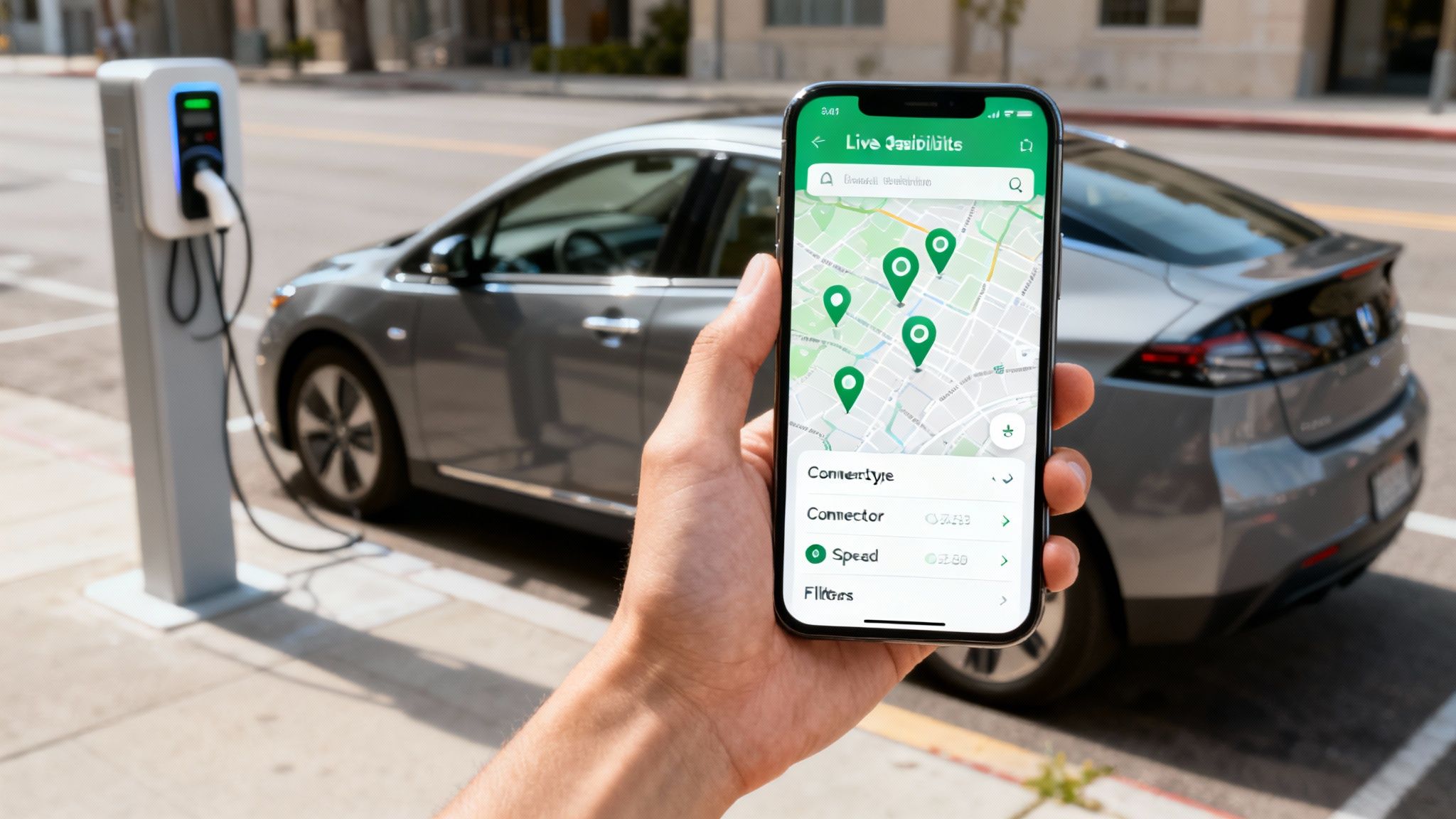
Right, the moment of truth. Your range is dipping into the ‘sweaty palms’ zone, and you need to find one of the thousands of fabled EV charging points in the UK . The good news is, you're not navigating blind. The bad news? It requires a bit more forward planning than popping to the corner shop for a pint of milk.
First things first, forget your car's built-in satnav. Seriously. It’s often years out of date and about as reliable as a chocolate teapot for finding chargers. Your new best friends are dedicated charging apps on your smartphone. They are, without a doubt, the single most important tool in your EV arsenal, turning a potential panic into a calm, collected pit stop.
The undisputed king of the UK charging scene is Zap-Map . Think of it as the Google Maps for EV drivers. It gives you a live view of nearly every public charger in the country, from the slowest lamppost unit to the beefiest ultra-rapid hub. Another fantastic option is PlugShare , which has a brilliant community focus, with drivers leaving helpful (and often scathing) comments and photos.
Mastering the Art of the App
Just opening an app and heading to the nearest pin on the map is pure amateur hour. To avoid a wasted journey and a stream of inventive cursing, you need to get friendly with the filters. This is non-negotiable.
Before you even think about setting off, filter that map down to show only what you and your car actually need. Trust me, it will save you a world of pain.
- Connector Type: Tell the app if you need a CCS , CHAdeMO , or Type 2 plug. It’s a bit pointless driving 10 miles to a charger that won’t physically fit your car.
- Charging Speed: Filter by the minimum speed you’ll accept. If you're on a motorway trip, you'll want to filter for 50kW+ rapid chargers to avoid accidentally navigating to a 7kW unit that would take all afternoon.
- Network: Got a subscription with a particular network? Or just prefer the comforting reliability of a provider like InstaVolt? Filter to show only their chargers.
- Live Availability: This is the big one. This filter uses live data to show you which chargers are currently in use, out of order, or, blissfully, free. Always, always check this.
Relying on live availability data is the difference between a smooth journey and a roadside tantrum. User comments are your secret weapon; a recent comment saying a charger is broken is often more up-to-date than the official network status itself.
The Charge Itself and What to Do When It Fails
You’ve found an available, working charger. Excellent. Now to persuade it to give you some electricity. Most modern rapid chargers have contactless payment, so you can just tap your bank card and get charging. For others, you’ll need to use the network’s own app or an RFID card. This is where those roaming services we mentioned earlier, like Octopus Electroverse, really prove their worth by giving you one card to rule them all.
For a full breakdown of the best tools for the job, have a look at our guide on how to find EV charging stations near me with top UK apps.
But what if it just… doesn’t work? First, don’t panic. Try the classic tech support solution: turn it off and on again. Abort the session on the screen and in your app, unplug the car, and start the whole process over. If it fails a second time, try a different unit at the same location if there is one. If all else fails, it’s time to move on to Plan B – the backup charger you cleverly identified before you set off. Because you did identify one, right?
A Quick Word on Charging Etiquette
Finally, a bit of common decency goes a very long way. The unwritten rules of the charging bay are simple but absolutely vital for stopping the EV community from descending into a Mad Max-style battle for electrons.
- Don’t Hog a Rapid Charger: These are for a quick splash-and-dash, not a weekly shop. Once your car hits 80% (or you have enough range to comfortably get where you’re going), unplug and move on.
- Park Properly: Please don’t be that person who straddles two bays, blocking another driver from being able to plug in.
- No ICEing: This is the ultimate sin. Never, ever park a petrol or diesel car (an Internal Combustion Engine) in a marked EV charging bay.
- Leave a Note: If you’re leaving your car on a slower charger for a while, some drivers leave a note on the dashboard with their mobile number. It’s a nice touch that can solve a lot of problems.
Home Charging: The Ultimate EV Life Hack
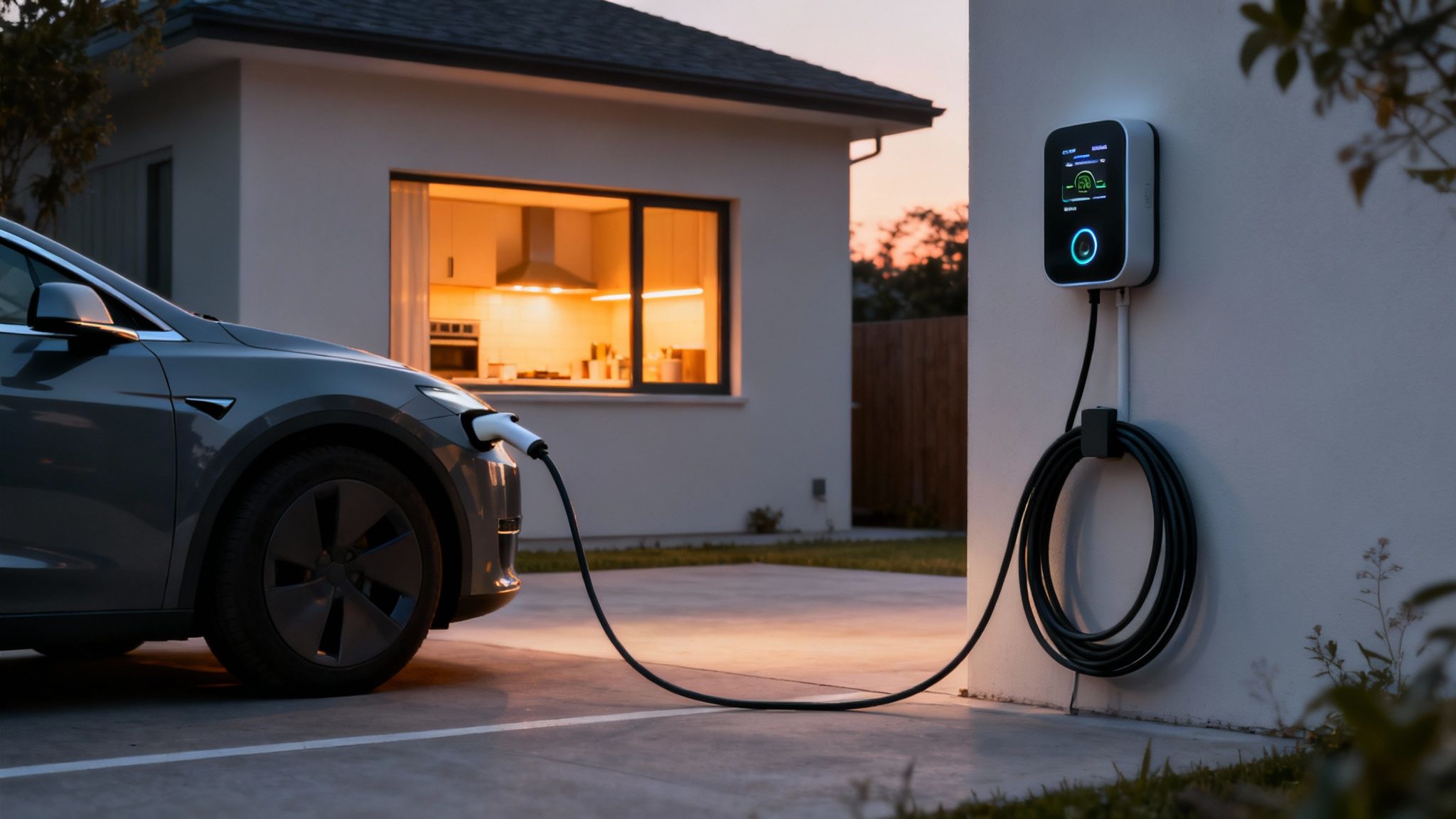
After all the talk of public networks, motorway madness, and juggling a dozen different apps, let's get to the single best part of owning an electric car. It’s not a flashy roaming card or finding an empty ultra-rapid charger. It's the simple, quiet satisfaction of waking up every morning with a full battery, without ever having left your driveway.
Home charging is the real secret sauce. It completely changes the game, shifting your mindset from planning trips around EV charging points in the UK to one of pure, effortless convenience. Think of it as having your own private, endlessly supplied petrol pump right outside your front door. For the vast majority of your daily driving, it makes public charging almost completely irrelevant.
While the UK’s public network is getting better all the time, the data shows where the real action is. A recent deep dive into driver habits revealed that a massive 77% of UK battery EV drivers regularly use a private home charger. That's a huge number, and it’s well above the European average of 66% . It tells you everything you need to know about where the smart money is.
The Good, The Bad, and The Three-Pin Plug
The most basic way to charge at home is with a standard three-pin wall socket, using what's often called a 'granny charger'. It’s simple and requires zero installation, but that’s where the good news ends. It’s painfully slow, trickling power in at just 2.3kW . For a modern EV with a decent-sized battery, you could be looking at more than 24 hours for a full charge. It’s a last-resort option, not something for your daily routine.
The real solution is a dedicated home wallbox. These units are professionally installed and typically deliver around 7kW of power, which completely transforms the experience. That slow trickle becomes a steady flow, easily giving you a full 'tank' overnight, every night. Waking up to 300 miles of range becomes your new, smug normal.
A dedicated 7kW home charger isn’t a luxury; it’s an essential piece of kit for any EV owner with a driveway. The convenience and cost savings make it one of the most sensible investments you can make.
Smart Charging and Saving a Fortune
Today's home chargers are much more than just powerful sockets; they're 'smart'. By connecting to your home Wi-Fi, they unlock the biggest single advantage of charging at home: ridiculously cheap electricity.
A smart charger lets you schedule your charging sessions via an app. This is absolutely key. You can plug your car in when you get home at 6 pm, but tell the charger not to bother starting until midnight, when off-peak electricity tariffs kick in. Those few hours can slash your 'fuel' costs, saving you a small fortune over the course of a year. We get into the nitty-gritty of this in our guide to finding the best EV home charger in the UK .
What About Grants and Costs?
A few years back, a government grant made home charger installation a bit cheaper for homeowners. That's now gone for most houses, but there's still help available for some.
- Renters and Flat Dwellers: The EV chargepoint grant can provide up to £350 towards the cost of installing a charger if you rent or own a flat.
- Landlords: Grants are also on offer for landlords who want to fit charge points at their properties, making it an easier conversation to have with them.
So, what's the damage? A fully installed 7kW smart wallbox will typically set you back somewhere between £800 and £1,200 , depending on the unit you choose and the complexity of the wiring job. It feels like a big outlay, but when you weigh it against the long-term savings on petrol and eye-wateringly pricey public chargers, you’ll find it pays for itself surprisingly quickly.
Your EV Charging Questions Answered
We’ve covered a lot of ground, from deciphering charger speeds to navigating the wild west of public networks. You should now have a decent grasp of the basics, but there are always a few lingering questions that seem to fall through the cracks.
Let's tackle some of the most common queries I hear from drivers. Think of this as the final, no-nonsense briefing you need before plugging in for real.
How Much Does It Actually Cost to Charge an EV in Public?
Right, let's get straight to it: it varies wildly. Honestly, the price you pay for a public top-up can feel like a complete postcode lottery, which remains one of the most frustrating parts of running an EV.
Slow lamppost chargers are often at the cheaper end, typically hovering around 30-40p per kilowatt-hour (kWh). Fast chargers at supermarkets are usually in a similar ballpark, and some are even free while you shop—a genuinely brilliant perk if you can find one.
The real sting in the tail comes from the rapid chargers you find at motorway service stations. These high-speed units can command anything from 60p to over 85p per kWh .
To give you a real-world example, fully charging a typical 60kWh battery could set you back over £50 at those top-end prices. At that point, your cost-per-mile starts to creep uncomfortably close to what you’d pay in an efficient petrol car.
If you’re a high-mileage driver who frequently relies on the public network, it’s well worth looking into network subscriptions. They can often bring that per-kWh cost down significantly.
Do I Really Need a Different App for Every Network?
A few years ago, the answer was a soul-crushing "yes." Your phone would be cluttered with apps and your wallet stuffed with more plastic RFID cards than a 90s sales rep. It was a proper pain in the backside.
Thankfully, things have moved on. The government finally stepped in, and now most new rapid chargers are legally required to accept contactless bank card payments. This makes life so much simpler—just tap your card and charge.
The real game-changers, though, are the roaming services we mentioned earlier. Think Octopus Electroverse , Zap-Pay , and Bonnet. These brilliant services bundle multiple networks under a single app and one monthly bill. You sign up once, get one card (or just use the app), and gain access to thousands of chargers from different brands. It’s how it should have been from the start.
What Happens If a Charger Is Broken or in Use?
This is the number one fear for anyone new to EVs and the true source of range anxiety. The best way to deal with it is to be prepared. A little bit of planning goes a long, long way.
Before you even think about setting off, check your app. Live maps like Zap-Map or PlugShare are your best friends here. They not only show if a charger is available but also feature recent comments from other drivers, which can be invaluable for spotting a faulty unit and saving you a wasted journey.
Here’s your simple action plan:
- Check Live Status: Before you go, open your app to check availability and what other drivers are saying.
- Have a Plan B: Always pinpoint a backup charger nearby, and maybe even a Plan C, just in case.
- Troubleshoot on Site: If you arrive and it’s genuinely broken, take a moment to report it in the app. You’ll be helping the next poor sod who comes along.
- Move On: Don’t waste time trying to fix it. Just head straight to your backup option.
It’s an annoyance, for sure. But with a bit of forward-thinking, a broken charger rarely has to turn into a full-blown crisis.
At VoltsMonster , we cut through the noise to give you honest, entertaining, and practical advice on the world of electric vehicles. For more straight-talking reviews and guides, check out our latest articles at https://www.voltsmonster.com.




